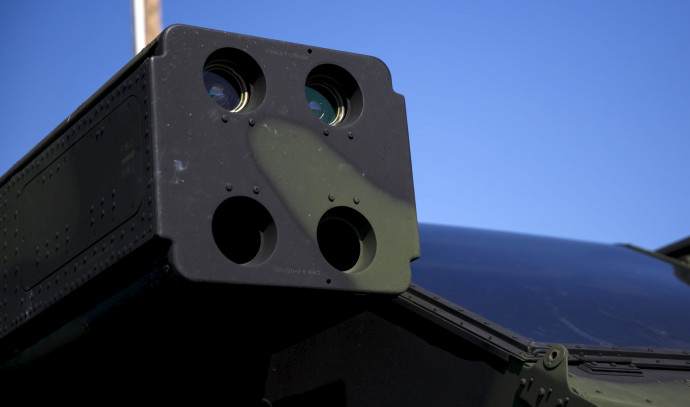The US Army continues to search for new unmanned aerial solutions for its needs on the future battlefield. This essentially means a competition among drone makers to make a new drone that the US can use.
The US Army program recently concluded a “base period” for the Future Tactical Uncrewed Aircraft Systems (FTUAS) Program of Record and is moving forward with four companies and their systems. These include Griffon Aerospace, Northrop Grumman Systems, Sierra Nevada Corporation, and Textron Systems Corporation.
A September 2020 article by the US Army noted that “the Future Tactical Unmanned Aircraft System (FTUAS) will be the replacement for the currently fielded RQ-7B Shadow in ground maneuver brigade combat teams.” The concept entails fielding drones that fly at a medium altitude and have modern “datalinks, Electro-Optical/Infra-Red (EO/ IR) sensors, Infra-Red/Laser pointer/Laser designator/Laser range finder, data encryption, manned-unmanned teaming capabilities and the ability to operate autonomously.” The drone that is chosen will be able to easily exchange various payloads and can be deployable via Chinook helicopters.
In 2020, the report said that that “FTUAS will be the brigade commanders’ primary day/night, reconnaissance, surveillance, and target acquisition system. It will allow the commander to see and understand the battle space and gain situational awareness on the battlefield. With runway independence, the system will expand the maneuver commander’s ability to conduct aerial reconnaissance where the terrain would limit access for ground recon assets. The FTUAS’ reduced acoustic signature will improve survivability and reduce the chance of alerting adversaries.”
The Ukraine war has given an incentive for Western militaries to accelerate these kinds of programs. In the old days, a country like the US could take years to do procurement of this kind and then not even use the results of the initiative. In short, in the old days bil, ions of dollars could be plowed into a lot of systems and not result in much. That is why it takes so long to develop and field various systems, including drones and advanced warplanes, and ships.
However, today the requirement to build things that work quickly is clear. Israel, by contrast, has often tried to invest in projects that work and which will be fielded quickly. Initiatives such as Iron Dome are an example of that kind of quick move from research and development to an operational system.
Drones are part of the future of warfare. They enable commanders to see a battlefield without risking troops or valuable warplanes; and they can also help with targeting and can be armed. Both Russia and Ukraine have used drones and also other unmanned systems, such as unmanned vessels.
The Shadow drone
The Shadow drone was developed in the 1990s. It owes some of its origins to the Pioneer drone which itself is a tactical unmanned system that was linked to Israel’s IAI Scout. The Shadow saw hundreds of thousands of flight hours in the early 2000s and continues to rack up successes.
Built by AAI, it is used by a half dozen countries, including the US. Now, as the US wants more new tactical drones it is tapping into key drone makers to produce the future.
Northrop Grumman, for instance, says it has teamed with Shield AI and “has been selected by the US Army to participate in the Future Tactical Unmanned Aircraft System (FTUAS) Increment 2 competition to replace the long-serving RQ-7B Shadow UAS. The FTUAS program calls for an easily and rapidly deployable vertical take-off and landing (VTOL) UAS delivering advanced reconnaissance, surveillance, and target acquisition capabilities to Brigade Combat Teams (BCTs) and Special Forces/Ranger battalions.”
A statement put out by the US Redstone Arsenal program executive office for the uncrewed aircraft systems project office details what comes next, “these systems will undergo numerous evaluation activities such as environmental testing, electromagnetic environmental effects testing, MOSA [modular open systems approach] verification, and flight testing conducted at PAH [Project Agreement Holders] and government test facilities.”
The current program for a future tactical drone includes a need for “runway independence, point take-off and landing, and a rapidly deployable UAS capability. When fielded, FTUAS will provide a distinct tactical advantage over current systems due to increased maneuverability through VTOL, improved command and control supported by the on-the-move capability, a reduced transportation and logistics footprint, as well as significantly improved survivability due to reduced noise signature.”
The candidates include the Griffon Valiant, which is a tiltrotor drone, meaning it can lift off like a helicopter and then fly forward. It has a sleek design. The Sierra Nevada Voly-T and Textron Aerosonde HQ are traditional-looking drones that also have a vertical take-off feature. The V-Bat by Northrop Grumman and Shield AI has a rotor on one end and can lift off point straight up, as a plane stood on its end; and then it transition to flying forward.
The current group of drones will eventually result in a new drone for the tactical capability that the US is looking for. One of these drones or something similar will likely go into production in several years. The vertical take-off flexibility will mean the drone no longer needs a runway or catapult to launch it into the air, which makes it easy to deploy and retrieve.
However, there are key questions about these types of drones and what other types of drones the US may want for tactical fighting. The US experience in drone warfare comes primarily from the period after the Cold War when the US had complete air superiority.
That means drones flew in uncontested airspace usually, in places like Iraq or Afghanistan, or even over other countries such as Pakistan, Somalia or Yemen. While the tactical drone is quite different than the larger Reaper or Global Hawk, it nevertheless may need to survive a battlefield if it is up against air defenses.
This raises questions about drone designs that essentially harken back to earlier eras with some changes. The drones built in the 1980s and 1990s that resulted in designs such as the Shadow were a product of a certain era. The modern battlefield of Ukraine shows how vulnerable drones are to air defenses and also shows how cheap drones that are designed to be lost in attrition warfare, may be more relevant.
The US has certainly learned from past experiences such as the Aquila, a drone that sponged up money but wasn’t used; but it’s unclear if the current thought process on the types of drones that battalions and brigades need is being thought through to give commanders what they need.



